Home
September 2017 - GQRP Club Audio Amplifier Chip TDA2822
In the Autumn 2017 Sprat our club sales manager Graham G3MFJ described a new audio amplifier chip that we have in stock for members at the very tempting price of 20 pence. A search on EBay will show that you can easily pay more than a pound for one. The TDA2822 is described as a monolithic integrated circuit in 8 pin D.I.L. package intended for use as dual audio power amplifier in portable cassette players and radios. The datasheet describes how it can be configured as a single channel amplifier (bridge mode) which is likely of more interest to us as QRPers.
Over the years, simple QRP radios have utilised old stalwarts such as the LM386 and LM380 chips (which are also pretty cheap). They have always seemed a bit wimpy to me in terms of actual gain. There have been clever tweaks to improve the gain but I still wouldn't call them "loud".
More recently we've seen attempts to break away from very simple and at the sacrifice of a little more complexity we get something with a lot more "wellie" in terms of output.
One example is the amplifier that Pete Juliano uses in his LBS design and has reused in his recent "Simpleceiver". This uses a combination of the NE5534 and LM380 for quite a useable amount of gain.
Pete's schematic can be found here.
This is a photo of one that I made using the "Muppet" style of construction.
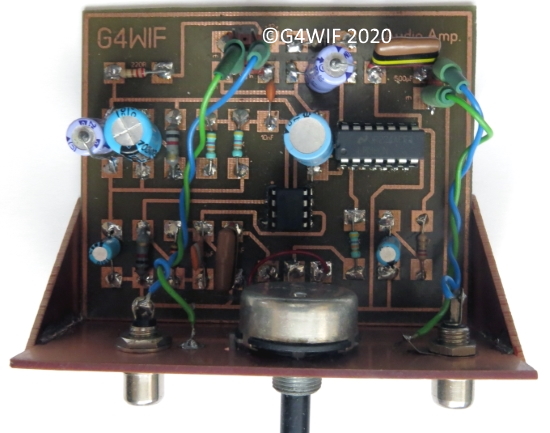
There is however always a quest for "really simple" and the club's recent acquisition of the TDA2822 chip fills that need. Here is the very simple circuit from the datasheet. It needs just ten components as shown below.
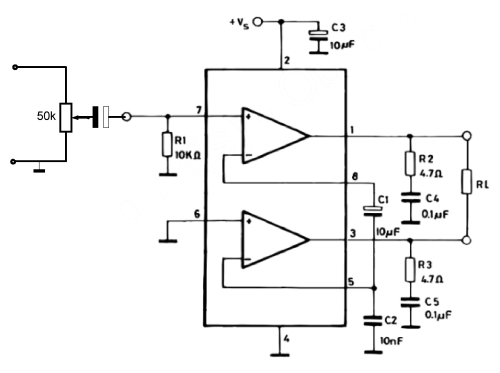
I etched a small printed circuit board to try the chip out. Really, this circuit is so simple it is ideal for dead bug construction or perfboard to be used. I just like the process of creating printed circuit boards and using the toner transfer method it doesn't take very long.
To test it I dug out an original 40m Rockmite which has a miniscule audio output. When measured, the audio signal rarely went above 40mV. With just headphones you could just about make out that there was some CW being received. [There is a new and improved version available at QRPme].
Although the datasheet allows up to 15 volt supply, early testing suggests that we are supplying a low voltage version. The gain produced with just 3 volt supply was quite impressive and I measured a current drain of under 10mA with an input signal. With none at all the quiescent current was in the low microamps.
I doubled the supply to 6 volts and it was louder for sure, but to my ear it didn't quite seem twice as loud. Certainly with a small loudspeaker of some two inches diameter you can hear the radio across the room.
This MP3 file demonstrates how loud the amplifier was with the recorder placed about a yard away.
At 6 volts, the current drawn had risen to 45mA. I left the amplifier running in the shack all day with a constant background of 40m CW and I would say that for the club TDA2822 chips this is an absolute safe maximum voltage.
However, given that most junk boxes probably contain a 5 volt regulator this is an ideal voltage to supply these chips while still getting a great deal of gain. Above 7 volts the chips start to get warm and they will of course expire when subjected to this kind of abuse. My advice would be to run it at a regulated 5 volts and it will be pretty much indestructable.
One final warning. As shown in the datasheet, in bridged configuration neither leg of the output is grounded so be careful to leave the loudspeaker floating..
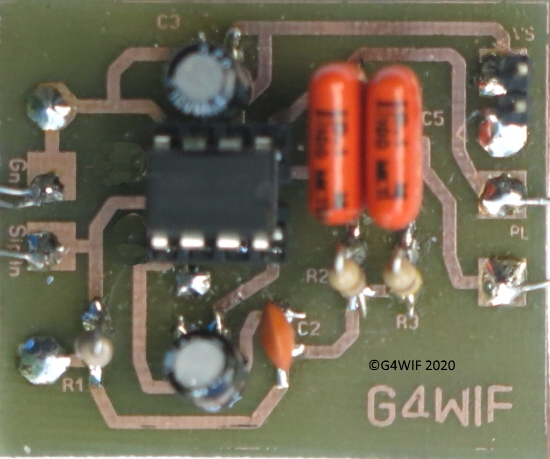
As you can see, my method is to use surface mount (muppet style) - even with conventional components.
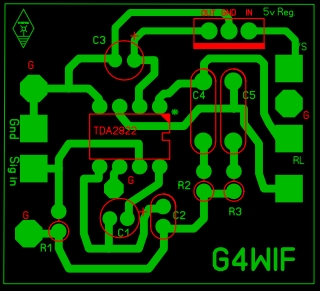
The board is about an inch high by 1.25 inches wide (here is the file). As with my other boards, the software that I use is “Sprint Layout”.
It isn’t free, but it isn’t expensive either.
http://www.abacom-online.de/uk/html/sprint-layout.html
But this is the free software for sharing...
http://www.abacom-online.de/updates/Sprint-Layout60_Viewer.exe
As an alternative, Nick G8INE produced a perfboard layout which is shown below:
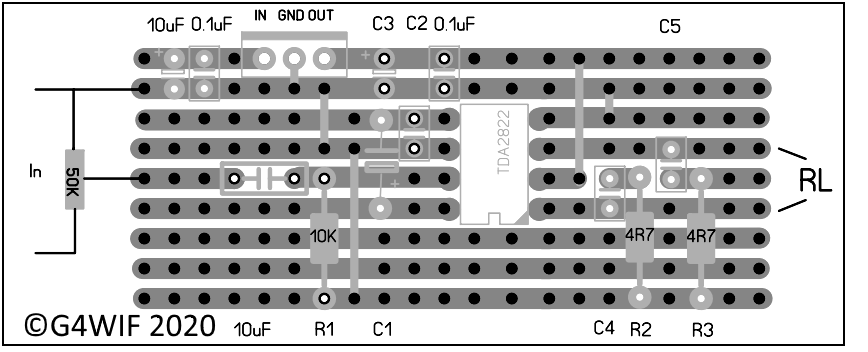
To order from the GQRP club you do have to be a member. The price of the items from club sales alone justifies the subscription but in addition you get four excellent quarterly magazines.